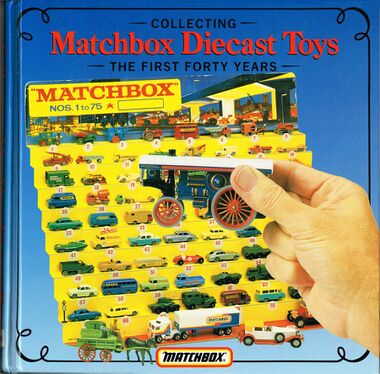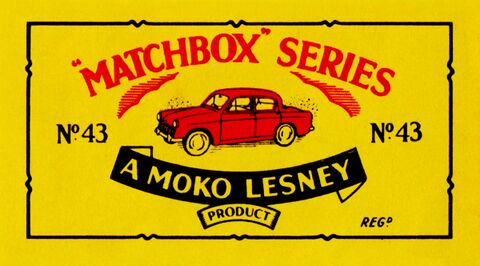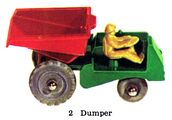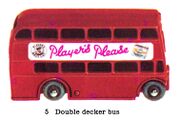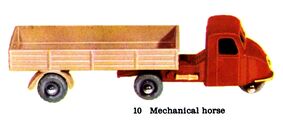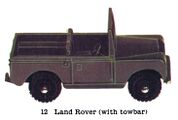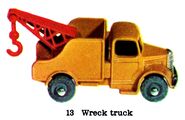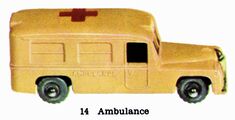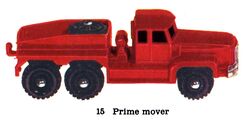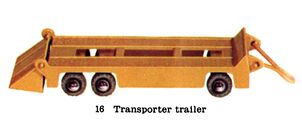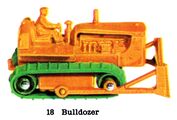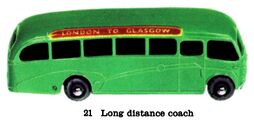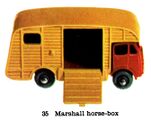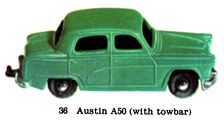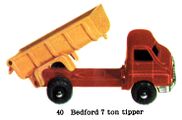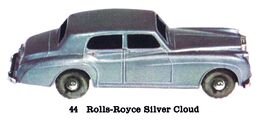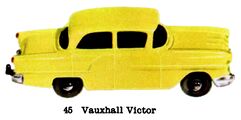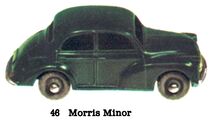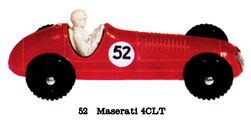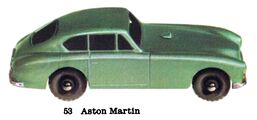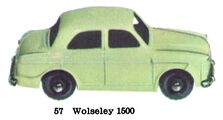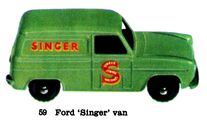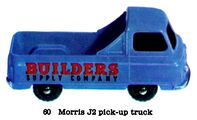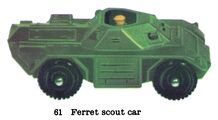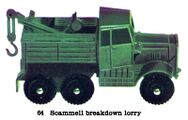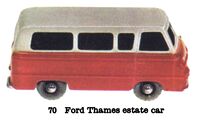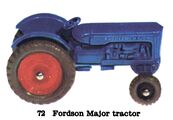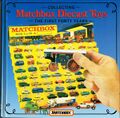Category:Matchbox Series
| Toy Brands and Manufacturers |
|---|
Matchbox Series |
| 1953 - |
1955: "Matchbox Miniature Models, a Moko-Lesney Product". 18 models listed. [image info]
1956 Moko-Lesney trade advert [image info]
1957: b&w copy of the colour 1957 fold-out product sheet. 42 models listed [image info]
1959: Lesney catalogue cover: 72 Matchbox models listed, plus accessories and Models of Yesteryear [image info]
1972: Front cover of "Lesney Matchbox 1-75 Series Diecasts", by Maurice A. Hammond [image info]
1989: Front cover of "Collecting Matchbox Diecast Toys, The First Forty Years" ISBN 0951088513, showing a "1-75" Matchbox dealer display stand [image info]
Lesney Products' Matchbox Series range of small diecast vehicles appeared in 1953, and were one of the classic ranges of "playground, carpet, garden and sandpit" toys. With no pretence at even attempting to use a common scale, Matchbox toys were individually sized to fit a matchbox, and were sold in matchbox-styled packaging.
Even though these were very much marketed as simple toys rather than models, the level of detailing specific to the original vehicle was pretty impressive, and the earliest-released models are particularly revered for their charm and attractiveness.
The "1-75" Series
The range of "playground and sandpit" toy vehicles became a runaway success, and after the initial launch in 1953 of three models, grew to eighteen in 1955, seventy-two in 1959, and finally seventy-five in 19xx. Seventy-five was considered a reasonable upper limit to the number of models that a retailer could be asked to handle, and not having a range in the hundreds meant that all the vehicles could be fairly distinctive, and make it easier for the customer to succumb to an impulse purchase without being confused by an overwhelming degree of choice.
At seventy-five models, the range "froze", with newcomers to the 1-75 Series" displacing older models. For retailers, this had the advantage that the existing point-of-sale display stands (with unlettered spaces marked 1-75) didn't need to be changed when the range changed.
Scale
The Matchbox range defiantly ignored any concept of unified scale, or an obvious unified theme, as typified by the initial three models, a diesel roller, a dumper truck and ... a static cement mixer (why a cement mixer, nobody knows, but it appeared to be perfectly scaled for gauge 0, and consequently appears on a lot of gauge 0 model railway layouts). The requirement that all models be roughly the same size meant that a Matchbox double decker bus was around the same size as a single-seater racecar (or a cement mixer!).
The 1959 range:
We've taken these scans from the 1959 catalogue, as representative of the early range – it's still only about six years after the initial launch, but has a range that almost reaches the magical "75" (72). Some models had already been changed by this point – the #1 Diesel Road Roller now had more modern slanted front roof supports, and the "Caterpillar Inc." vehicles had different engine cowlings (D4 rather than D2?)
- 1 – Diesel Road Roller, green
- 2 – Muir Hill Dumper, green and red
- 3 – Cement Mixer, blue
- 4 – Massey Harris Tractor, red
- 5 – Red Double-Decker Bus, "Player's Please"
- 6-B – Euclid Quarry Truck, yellow
- 7 – Horse-Drawn Milk Float, red
- 8-B – Caterpillar (D4?) Tractor, yellow
- 9 – Dennis Fire Engine (listed as "Fire Escape"), red
- 10 – Scammell Scarab Mechanical Horse, red cab
- 11 – Road Petrol Tanker, red
- 12 – Land Rover (with towbar)
- 13 – Fordson Thames Wreck Truck, crane
- 14 – Daimler Ambulance, Red Cross, cream
- 15 – Prime Mover six-wheeler truck cab, red
- 16 – Atlantic Vehicle Transporter Trailer, orange
- 17 – Bedford Removals Van, "Matchbox Removals Service", green
- 18 – Caterpillar (D4?) Bulldozer, yellow with green tracks
- 19 – MG MGA Sports Car, white
- 20 – ERF Heavy Lorry, "Ever Ready for Life!", blue
- 21 – Bedford Duple Long-Distance Luxury Coach, "London to Glasgow", green
- 22 – Vauxhall Cresta car, pale pink
- 23-B – Berkeley Cavalier Caravan, yellow-green
- 24 – Weatherill Hydraulic Excavator, orange
- 25 – Bedford 12 cwt Van, "Dunlop", blue
- 26 – Foden Cement Mixer Lorry, orange
- 27 – Bedford Low Loader Articulated Lorry, green cab
- 28 – Ford Thames Compressor Lorry, orange
- 29 – Bedford Milk Delivery Van, cream
- 30 – Ford Prefect car, with towbar
- 31 – American Ford Customline Station Wagon ( "Country Sedan"), yellow
- 32 – Jaguar XK140 Fixed-Head Coupé, off-white
- 33 – Ford Zodiac car with Towbar, green
- 34 – Volkswagen Microvan, "Matchbox International Express" blue
- 35 – ERF Marshall Horse Box Mk.7, red cab
- 36 – Austin A50, green
- 37 – Karrier Bantam Coca-Cola bottle lorry, even load
- 38 – Karrier Bantam Refuse Truck, "Cleansing Department", grey
- 39 – Ford Zodiac Convertible car, with Towbar
- 40 – Bedford 7-Ton Tipper, red cab
- 41 – D-Type Jaguar racing car, green
- 42 – Bedford Van, "Evening News", "First With The News", yellow
- 43 – Hillman Minx Mk.2 car, two-tone light blue and grey
- 44 – Rolls-Royce Silver Cloud, silver
- 45 – Vauxhall Victor car, yellow
- 46 – Morris Minor car, dark green
- 47 – Trojan 1-Ton Van, "Brooke Bond", red
- 48 – Fenn & Wood Meteor Sportsman Sports Boat on Trailer, blue and wood-effect
- 49 – US Army M3 Half-Track Personnel Carrier, green
- 50 – Commer Pickup Truck, buff
- 51 – Albion Lorry, "Blue Circle", "Portland Cement", yellow
- 52 – Maserati 4CLT single-seater racing car, red
- 53 – Aston-Martin DB2/4 Mk I car, metallic light green
- 54 – Alvis Saracen Six-Wheeled Personnel carrier, green
- 55 – US Army DUKW-353 "Duck" Amphibious Vehicle, green
- 56 – Red London Trolleybus, "Drink Peardrax Sweet Sparkling"
- 57 – Matchbox No.57, Wolseley 1500 car, pale green
- 58 – AEC Coach, "British European Airways" (BEA), blue
- 59 – Ford Van, "Singer", green
- 60 – Morris Commercial J2 Pickup Truck, "Builders Supply Company", blue
- 61 – British Army Daimler Ferret Mk1 Armoured Scout Car, green
- 62 – British Army AEC Militant ("Milly") General Service Lorry, green
- 63 – Ford 3 Ton 4×4 Service Ambulance, Red Cross, green
- 64 – Scammell Army Breakdown Truck, green
- 65 – Jaguar 3.4 litre Sedan, blue
- 66 – Citroën DS19 car, yellow
- 67 – British Army Alvis FV601 Saladin six-wheeled armoured car, green
- 68 – British Army Austin Mark II Radio Truck, green
- 69 – Commer 30 cwt Van, "Nestle's", crimson
- 70 – Ford Thames Estate Car, two-tone red and white
- 71 – British Army Austin 200-Gallon Water Truck, green
- 72 – Fordson Major Tractor, blue
Lledo
Lesney went bust in 1982, after which Jack Odell came out of retirement, bought some of the more "retro" Matchbox moulds and produced a new Days Gone range under the name Lledo.
See also:
External links
- The Matchbox Club (matchboxclub.com)
- "Lesney’s Matchbox series – One of the best toy cars of all time", by Milica Sterjova (wallswithstories.com)
- "Sixty years of Matchbox cars", by Chris Knapman (telegraph.co.uk)
- The man who made the first boyish Matchbox toy actually made it for his DAUGHTER (dailymail.co.uk)
Subcategories
This category has the following 10 subcategories, out of 10 total.
A
- Matchbox Accessories (6 P, 4 F)
J
L
M
- Matchbox Major (5 P, 4 F)
- Matchbox Motorway (2 P, 5 F)
- Matchbox Roadway (1 F)
- Matchbox Series (display) (16 P, 14 F)
U
- Matchbox in the USA (1 F)
Y
Pages in category ‘Matchbox Series’
The following 20 pages are in this category, out of 20 total.
A
B
F
P
Media in category ‘Matchbox Series’
The following 124 files are in this category, out of 124 total.
- 1908 Grand Prix Mercedes, Matchbox Y10-1 (MBCat 1959).jpg 1,947 × 1,171; 641 KB
- 1926 Morris Cowley Bullnose, Matchbox Y8-1 (MBCat 1959).jpg 1,790 × 1,156; 611 KB
- 1929 Le Mans Bentley, Matchbox Y5-1 (MBCat 1959).jpg 2,057 × 1,157; 638 KB
- 4 Ton Leyland, Matchbox Y7-1 (MBCat 1959).jpg 1,869 × 1,157; 759 KB
- Accessory Pack, angle (Matchbox Motorway X1).jpg 1,600 × 1,115; 1.14 MB
- Accessory Pack, box base (Matchbox Motorway X1).jpg 1,600 × 799; 890 KB
- Accessory Pack, box top (Matchbox Motorway X1).jpg 1,600 × 798; 788 KB
- AEC Y Type Lorry, Matchbox Y6-1 (MBCat 1959).jpg 1,878 × 1,157; 721 KB
- Albion Portland Cement Lorry, Matchbox No51 (MBCat 1959).jpg 1,649 × 815; 618 KB
- Allchin 1925 Traction Engine (Matchbox MYY Y1).jpg 2,000 × 1,495; 1.13 MB
- Allchin 7NHP Traction Engine, Matchbox Y1-1 (MBCat 1959).jpg 1,687 × 1,293; 728 KB
- Ambulance, Matchbox No14 (MBCat 1959).jpg 1,504 × 771; 498 KB
- American 4-4-0 Locomotive, Matchbox Y13-1 (MBCat 1959).jpg 1,921 × 1,160; 682 KB
- American Ford Station Wagon, Matchbox No31 (MBCat 1959).jpg 1,699 × 806; 576 KB
- Army Half-Track, Matchbox No49 (MBCat 1959).jpg 1,589 × 850; 579 KB
- Army Saracen Carrier, Matchbox No54 (MBCat 1959).jpg 1,479 × 880; 514 KB
- Aston Martin, Matchbox No53 (MBCat 1959).jpg 1,720 × 804; 546 KB
- Austin A50 with Towbar, Matchbox No36 (MBCat 1959).jpg 1,450 × 780; 454 KB
- Austin Mark II Radio Truck, Matchbox No68 (MBCat 1959).jpg 1,600 × 1,027; 632 KB
- Aveling and Porter Steam Roller, Matchbox Y11-1 (MBCat 1959).jpg 2,092 × 1,451; 922 KB
- Aveling Porter 1894 steamroller, James Young and Sons (Matchbox MYY Y21-3).jpg 2,000 × 1,334; 1.1 MB
- Aveling Porter 1920 steamroller (Matchbox MYY Y11).jpg 2,000 × 1,320; 1.13 MB
- B Type London Bus, Matchbox Y2-1 (MBCat 1959).jpg 1,669 × 1,281; 746 KB
- Bedford 12 cwt Van, Matchbox No25 (MBCat 1959).jpg 1,389 × 908; 548 KB
- Bedford 7-Ton Tipper, Matchbox No40 (MBCat 1959).jpg 1,480 × 978; 459 KB
- Bedford Articulated Walls Lorry, Matchbox Major Pack 2 (MBCat 1959).jpg 2,550 × 1,196; 1.39 MB
- Bedford Car Transporter, Matchbox Accessory Pack 2 (MBCat 1959).jpg 3,000 × 1,053; 1.32 MB
- Bedford Evening News Van, Matchbox No42 (MBCat 1959).jpg 1,503 × 1,067; 707 KB
- Bedford Low Loader, Matchbox No27 (MBCat 1959).jpg 2,342 × 798; 594 KB
- Bedford Milk Delivery van, Matchbox No29 (MBCat 1959).jpg 1,490 × 963; 640 KB
- British European Airways Coach, Matchbox No58 (MBCat 1959).jpg 1,600 × 832; 598 KB
- Bulldozer, Matchbox No18 (MBCat 1959).jpg 1,327 × 903; 509 KB
- Caravan, Matchbox No23 (MBCat 1959).jpg 1,620 × 968; 655 KB
- Caterpillar Earth Mover, Matchbox Major Pack 1 (MBCat 1959).jpg 2,778 × 1,030; 957 KB
- Caterpillar Tractor, Matchbox No8-B (MBCat 1959).jpg 1,127 × 864; 444 KB
- Cement Mixer, Matchbox No3 (MBCat 1959).jpg 1,054 × 1,059; 440 KB
- Citroen DS19, Matchbox No66 (MBCat 1959).jpg 1,600 × 725; 432 KB
- Coca-Cola Lorry, Matchbox No37 (MBCat 1959).jpg 1,454 × 853; 554 KB
- Collecting Matchbox Diecast Toys, The First Forty Years (ISBN 0951088513).jpg 1,200 × 1,182; 1.19 MB
- Commer 30 cwt Van, Matchbox No69 (MBCat 1959).jpg 1,400 × 893; 502 KB
- Commer Pickup, Matchbox No50 (MBCat 1959).jpg 1,630 × 815; 567 KB
- D Type Jaguar, Matchbox No41 (MBCat 1959).jpg 1,436 × 720; 336 KB
- Diesel Road Roller, Matchbox No1 (MBCat 1959).jpg 1,585 × 1,049; 552 KB
- Double Decker Bus, Matchbox No5 (MBCat 1959).jpg 1,505 × 1,005; 648 KB
- DUKW Amphibian, Matchbox No55 (MBCat 1959).jpg 1,793 × 767; 474 KB
- Dumper Truck, Matchbox No2 (MBCat 1959).jpg 1,257 × 879; 425 KB
- Esso Pumps and Forecourt Sign, Matchbox Accessory Pack 1 (MBCat 1959).jpg 2,922 × 2,011; 1,022 KB
- Excavator, Matchbox No24 (MBCat 1959).jpg 1,608 × 915; 552 KB
- Extension Set, box lid (Matchbox Motorway E2).jpg 1,200 × 762; 671 KB
- Ferret Scout Car, Matchbox No61 (MBCat 1959).jpg 1,503 × 828; 423 KB
- Fire Engine, Matchbox No9 (MBCat 1959).jpg 1,426 × 860; 477 KB
- Foden 1922 Steam Wagon with Traction Engine (Matchbox, Roslyn).jpg 1,024 × 683; 342 KB
- Ford Prefect with Towbar, Matchbox No30 (MBCat 1959).jpg 1,512 × 789; 469 KB
- Ford Singer Van, Matchbox No59 (MBCat 1959).jpg 1,473 × 857; 542 KB
- Ford Thames Compressor Lorry, Matchbox No28 (MBCat 1959).jpg 1,574 × 991; 631 KB
- Ford Thames Estate Car, Matchbox No70 (MBCat 1959).jpg 1,403 × 853; 491 KB
- Ford Zodiac Convertible with Towbar, Matchbox No39 (MBCat 1959).jpg 1,668 × 784; 543 KB
- Ford Zodiac with Towbar, Matchbox No33 (MBCat 1959).jpg 1,646 × 780; 469 KB
- Fordson Major Tractor, Matchbox No72 (MBCat 1959).jpg 1,316 × 914; 437 KB
- Fowler 1905 B6 Showmans Engine (Matchbox MYY 19-2).jpg 2,000 × 1,304; 437 KB
- Fowler 1924 Showmans Engine (Lesney MYY No9).jpg 1,600 × 964; 254 KB
- Fowler Big Lion Showmans Engine, Matchbox Y9-1 (MBCat 1959).jpg 2,174 × 1,457; 1.27 MB
- General Service Lorry, Matchbox No62 (MBCat 1959).jpg 1,600 × 883; 566 KB
- Gift Set G-6, Models of Yesteryear, box lid (Lesney G-6).jpg 1,600 × 1,095; 1.05 MB
- GWR Duke of Connaught Locomotive, Matchbox Y14-1 (MBCat 1959).jpg 1,843 × 1,165; 648 KB
- Heavy Lorry, Matchbox No20 (MBCat 1959).jpg 1,715 × 833; 507 KB
- Hillman Minx, Matchbox No43 (MBCat 1959).jpg 1,698 × 824; 568 KB
- Horse Bus, Matchbox Y12-1 (MBCat 1959).jpg 2,079 × 1,466; 883 KB
- Horse-Drawn Fire Engine (Matchbox MOY Y4-2).jpg 800 × 502; 285 KB
- Horse-Drawn Milk Float, Matchbox No7 (MBCat 1959).jpg 1,449 × 1,021; 464 KB
- Jaguar 3point4 Litre, Matchbox No65 (MBCat 1959).jpg 1,570 × 730; 414 KB
- Jaguar XK140 Fixed-Head Coupe, Matchbox No32 (MBCat 1959).jpg 1,467 × 746; 418 KB
- Land Rover with Towbar, Matchbox No12 (MBCat 1959).jpg 1,460 × 985; 462 KB
- LCC E Class Tramcar, Matchbox Y3-1 (MBCat 1959).jpg 1,967 × 1,349; 979 KB
- Lesney Matchbox 1-75 Series Diecasts, cover (Maurice A Hammond).jpg 1,200 × 903; 603 KB
- Lesney Matchbox Catalogue, cover (MBCat 1959).jpg 1,200 × 906; 925 KB
- Long Distance Coach, Matchbox No21 (MBCat 1959).jpg 1,650 × 780; 529 KB
- Main Highway, Matchbox Roadway R-1 (MM 1964-12).jpg 1,501 × 1,084; 241 KB
- Marshall Horse Box, Matchbox No35 (MBCat 1959).jpg 1,341 × 1,068; 602 KB
- Maserati 4CLT, Matchbox No52 (MBCat 1959).jpg 1,598 × 767; 325 KB
- Matchbox Miniature Models (BPO 1955-10).jpg 2,170 × 3,000; 1.66 MB
- Matchbox Series, display cabinet (2015).jpg 1,800 × 1,200; 1.35 MB
- Matchbox Series, range of models, sheet front panel (Lesney 1957).jpg 1,200 × 788; 423 KB
- Mechanical Horse, Matchbox No10 (MBCat 1959).jpg 1,925 × 818; 553 KB
- Metal Lock-Up Garage, Matchbox Accessory Pack 3 (MBCat 1959).jpg 2,457 × 1,306; 1.42 MB
- Meteor Sports Boat on Trailer, Matchbox No48 (MBCat 1959).jpg 1,680 × 862; 470 KB
- MGA Sports Car, Matchbox No19 (MBCat 1959).jpg 1,404 × 713; 346 KB
- Models of Yesteryear advert, Lesney (VCC 1963).jpg 1,499 × 2,200; 1.02 MB
- Models of Yesteryear, Matchbox (MBCat 1959).jpg 1,200 × 898; 805 KB
- Models of Yesteryear, Moko Lesney Matchbox, box lid artwork.jpg 1,200 × 699; 708 KB
- Moko Lesney Matchbox Series, box lid artwork.jpg 1,200 × 664; 517 KB
- Moko-Lesney Matchbox trade advert (Gat 1956).jpg 628 × 1,024; 120 KB
- Morris J2 Pickup Truck, Matchbox No60 (MBCat 1959).jpg 1,477 × 903; 528 KB
- Morris Minor, Matchbox No46 (MBCat 1959).jpg 1,341 × 752; 396 KB
- Patent application, Hans Biller, Matchbox Motorway (GB1029649 1965).jpg 1,443 × 1,032; 226 KB
- Prime Mover, Matchbox No15 (MBCat 1959).jpg 1,683 × 821; 508 KB
- Quarry Truck, Matchbox No6 (MBCat 1959).jpg 1,622 × 1,013; 540 KB
- Ready-mixed Concrete Lorry, Matchbox No26 (MBCat 1959).jpg 1,112 × 861; 442 KB
- Refuse Wagon, Matchbox No38 (MBCat 1959).jpg 1,551 × 830; 566 KB
- Removals Van, Matchbox No17 (MBCat 1959).jpg 1,408 × 966; 599 KB
- Road Tanker, Matchbox No11 (MBCat 1959).jpg 1,641 × 807; 600 KB
- Rolls-Royce Silver Cloud, Matchbox No44 (MBCat 1959).jpg 1,704 × 791; 548 KB
- Ruston-Bucyrus 22-RB Excavator, Matchbox Major Pack 4 (MBCat 1959).jpg 2,166 × 1,609; 1 MB
- Saladin Armoured Car, Matchbox No67 (MBCat 1959).jpg 1,561 × 965; 510 KB
- Scammell Breakdown Lorry, Matchbox No64 (MBCat 1959).jpg 1,600 × 1,025; 679 KB
- Sentinel Steam Wagon, Matchbox Y4-1 (MBCat 1959).jpg 1,878 × 1,157; 580 KB
- Service Ambulance, Matchbox No63 (MBCat 1959).jpg 1,600 × 990; 619 KB
- Service Water Truck, Matchbox No71 (MBCat 1959).jpg 1,600 × 966; 540 KB
- Showroom and Service Station, Matchbox Accessory Pack (MBCat 1959).jpg 3,000 × 1,083; 1,023 KB
- This Is Matchbox (BoysLife 1965-10).jpg 3,000 × 1,934; 1.12 MB
- Thunderbirds Rescue Pack (Matchbox TB700).jpg 2,200 × 1,669; 720 KB
- Thunderbirds Rescue Pack, base (Matchbox TB700).jpg 2,200 × 1,653; 747 KB
- Tractor, Matchbox No4 (MBCat 1959).jpg 1,193 × 840; 396 KB
- Transporter Trailer, Matchbox No16 (MBCat 1959).jpg 1,854 × 739; 443 KB
- Trojan Van, Brooke Bond, Matchbox No47 (MBCat 1959).jpg 1,568 × 997; 659 KB
- Trolley Bus, Matchbox No56 (MBCat 1959).jpg 1,600 × 1,003; 715 KB
- Vauxhall Cresta, Matchbox No22 (MBCat 1959).jpg 1,651 × 801; 510 KB
- Vauxhall Victor, Matchbox No45 (MBCat 1959).jpg 1,536 × 767; 423 KB
- Volkswagen Microvan, Matchbox No34 (MBCat 1959).jpg 1,407 × 833; 526 KB
- W and R Jacobs Biscuits van (Matchbox).jpg 2,000 × 1,126; 1 MB
- Wolseley 1500, Matchbox No57 (MBCat 1959).jpg 1,420 × 765; 401 KB
- Wreck Truck, Matchbox No13 (MBCat 1959).jpg 1,346 × 876; 452 KB






